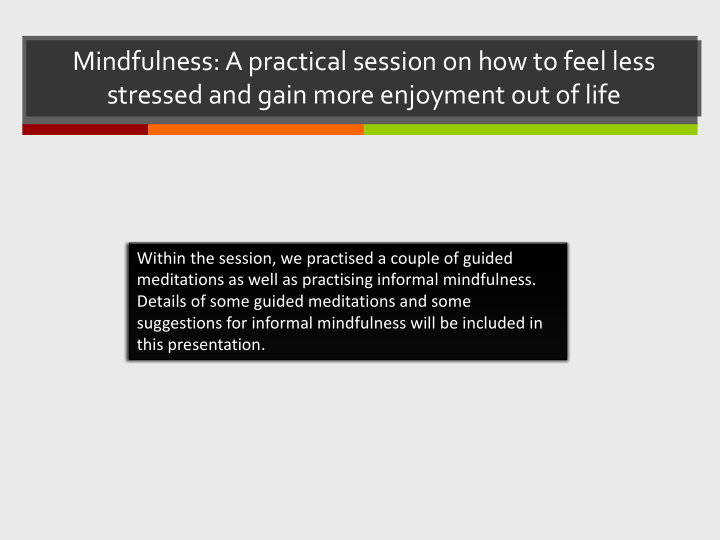



Mindfulness: A practical session on how to feel less stressed and gain more enjoyment out of life Within the session, we practised a couple of guided meditations as well as practising informal mindfulness. Details of some guided meditations and some suggestions for informal mindfulness will be included in this presentation.
Aims and Objectives To offer an overview of what Mindfulness is and the benefits of practising § Mindfulness To participate in several practice exercises to offer an experiential § understanding of Mindfulness To consider how you can incorporate Mindfulness practice into your working § day
Definition of Mindfulness Mindfulness means paying attention to what’s happening in the present § moment in the mind, body and external environment, with an attitude of curiosity and kindness Mindful awareness can be cultivated by engaging in a range of simple § meditation practices
How Mindful are you? Many people live their life on autopilot, struggling to focus on present tasks, § distracted by their thoughts and feelings relating to both past and future events The ‘Mindful Attention Awareness Scale’ can be used as a tool to assess § how ‘in the moment’ you are
Types of Mindfulness Practice Mindfulness practice can be formal or informal § Formal practice refers to mindfulness meditation which can be practised § sitting, lying down, standing, or moving Informal practice refers to the weaving of mindful awareness into everyday § activities, such as eating, showering, walking and interpersonal interactions.
Formal Practice: Mindfulness Meditation Mindfulness meditation involves directing your attention to a specific focus § The focus could be your breath, a sensation, a feeling, a sound, or some § other type of anchor When you practice mindful meditation you will notice that your mind will § repeatedly drift away from your chosen anchor It may drift to other thoughts, images, memories, feelings, sounds § When you notice it drifting try to bring your attention back repeatedly to the § anchor
The benefits of practising Mindfulness People who regularly carry out mindfulness may experience the following benefits: Feeling calmer and more relaxed; § Increased levels of energy and enthusiasm for their job and life in general; § Increased efficiency when carrying out tasks; § More enjoyment out of the activity; § Increased confidence, self-compassion and compassion for others; § A reduction in stress, anxiety and low mood. §
The benefits of practising Mindfulness Changes in our brain and body MRI studies examining the impact of mindfulness have shown that mindfulness meditation appears to reshape the neural pathways, increasing the density and complexity of connections in areas associated with cognitive abilities (e.g. attention and self- awareness) and emotional areas (e.g. kindness and compassion) Activity and growth is decreased in areas involved in anxiety, worry and impulsivity
Informal Practice: Experiencing simple, routine tasks in a Mindful way This practice is about using your senses and absorbing the detail of the task you are focused on. Stay in the moment and really think about what you’re doing. You could choose to: Eat and drink mindfully § Brush your teeth mindfully § Shower mindfully § Get dressed mindfully § Travel to work mindfully § Listen to the radio/watch television mindfully § Have a mindful conversation §
Incorporating Mindfulness into your day Ø Try the 5-3-1 daily practice for well-being in the work-place Ø Mindfully meditate 5 minutes each day. Try to find a regular time for a formal sitting practice that you can maintain on a regular basis. A guided audio recording can be good to start with. It’s the regularity of the practice that is most important. Ø Identify 3 things that you are grateful for at the end of each working day Ø Make time for at least 1 act of kindness each day
Incorporating Mindfulness into your day A useful exercise during a hectic movement, when you want to feel calm. Stop what you are doing and take three long, slow mindful breaths. How to do this: You could place the palm of your hand onto your tummy and notice your tummy 1. rise on the in breath and fall on the out breath. Feel the flow of air as it fills your body from your nose to the bottom of your lungs. 2. Then feel the air flow out of your body. After your third breath, allow your breathing to return to normal and notice how 3. you feel *Your breaths should be slow and deep but not uncomfortable. Don’t hold your breath or try to inhale or exhale too quickly.
References Visit CIRCULARITY.ORG then search under Proud, Mindfulness § and Meditation for some of Rachel’s audio files. http://www.freemindfulness.org/download A really useful website with various mindfulness exercises which § are free to download The Little Book of Mindfulness. 10 Minutes a Day to Less Stress More Peace. Dr Patrizia Collard A fantastic book which offers a great overview and lots of § exercises
The application of Mindfulness Mindfulness is recommended by the Department of Health and is viewed as § an effective strategy for managing stress, anxiety and depression. If practised on a daily basis Mindfulness can reduce the likelihood of us experiencing such difficulties More than 10,000 published research papers are available § There are lots of online videos and apps with a wide variety of mindfulness § exercises on Daily Mindfulness practice is now incorporated into various work § environments and educational settings
Recommend
More recommend